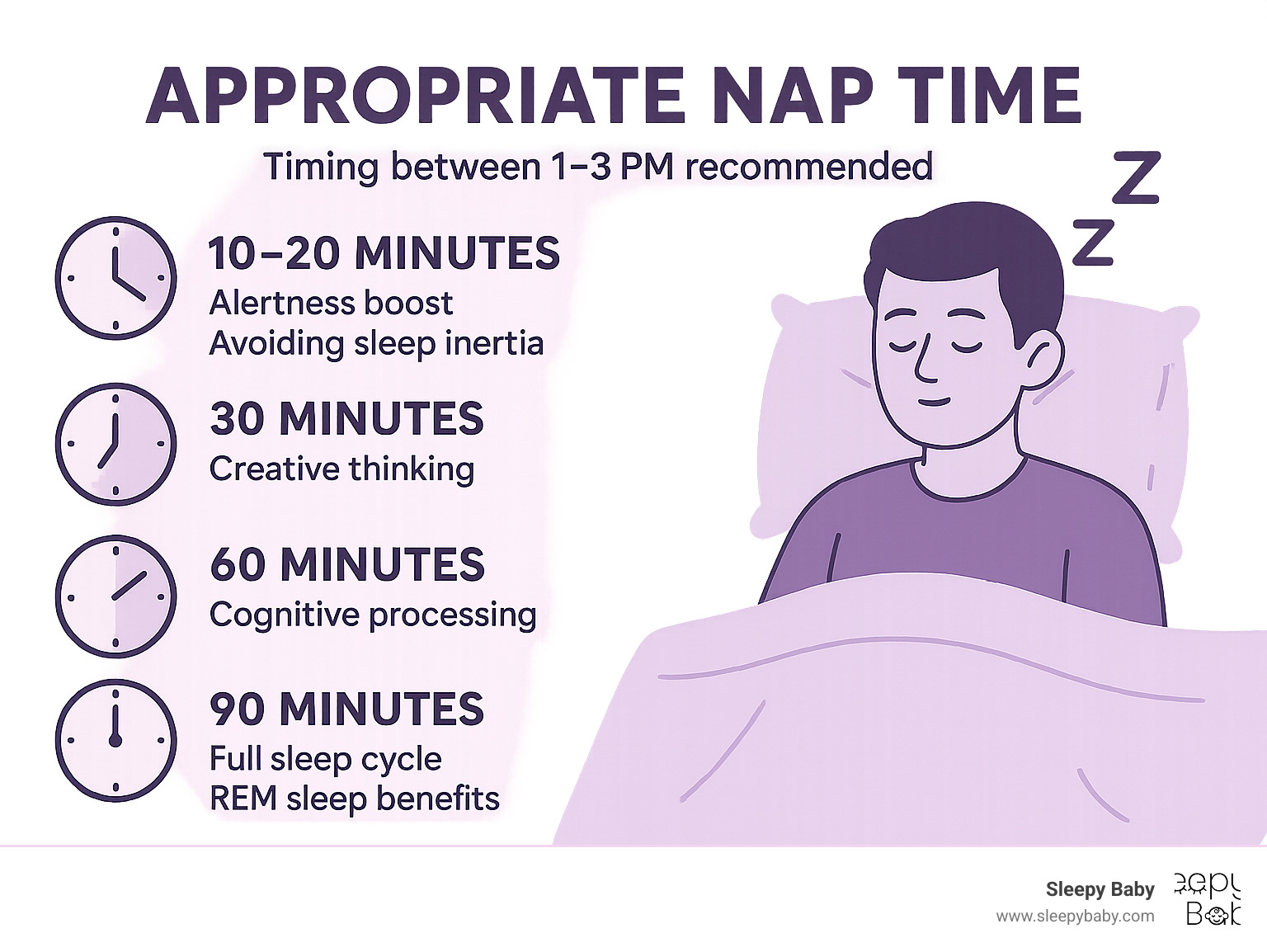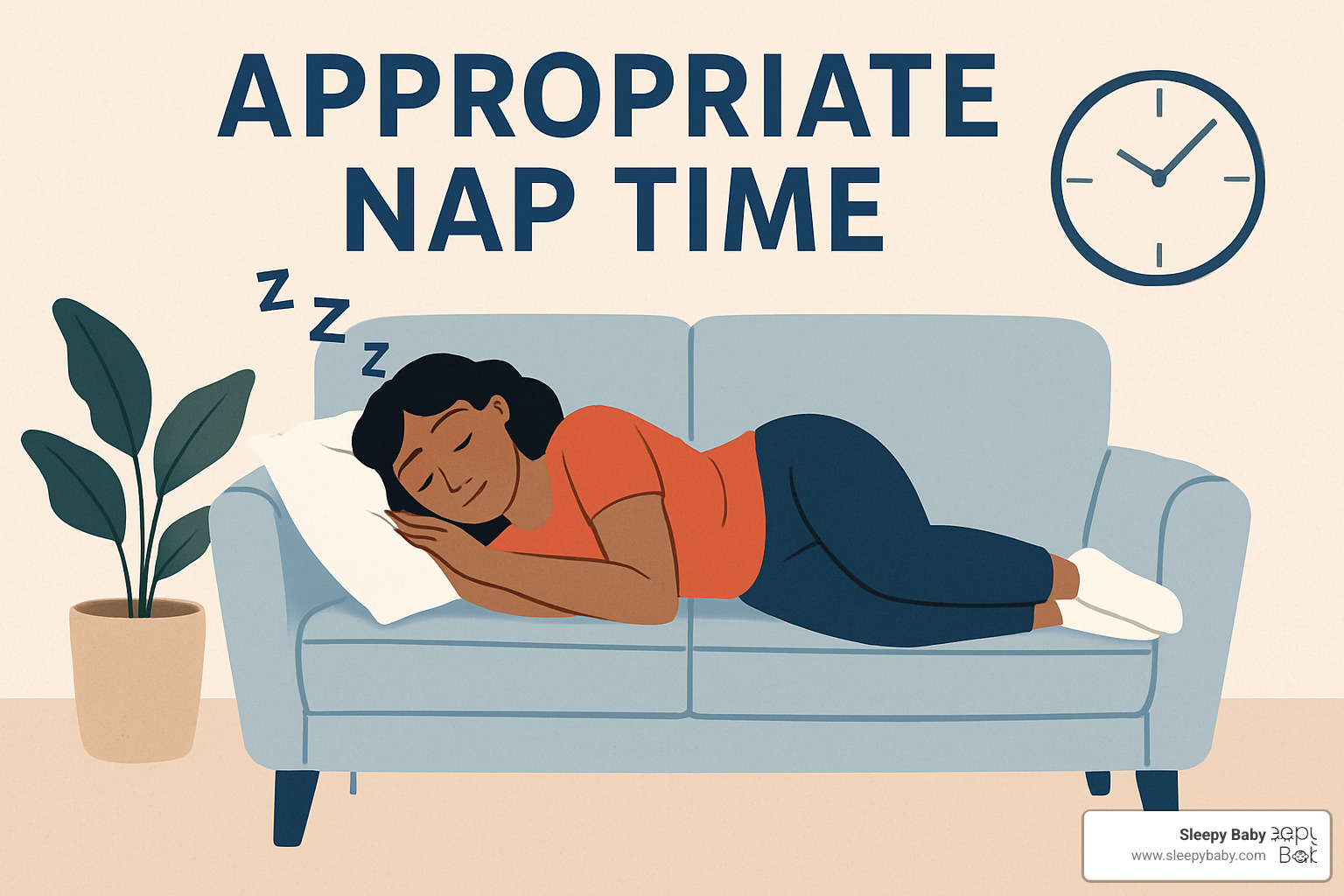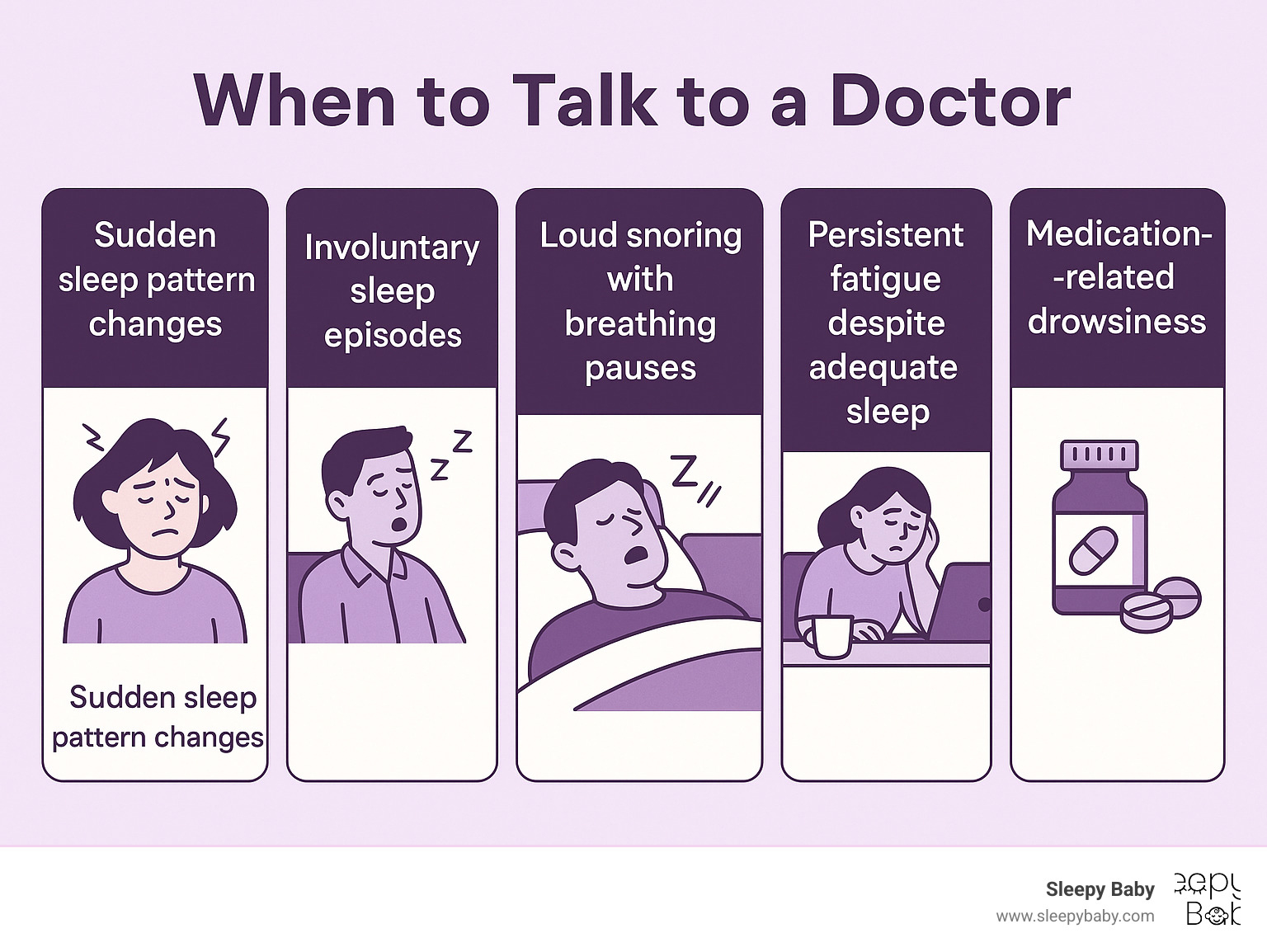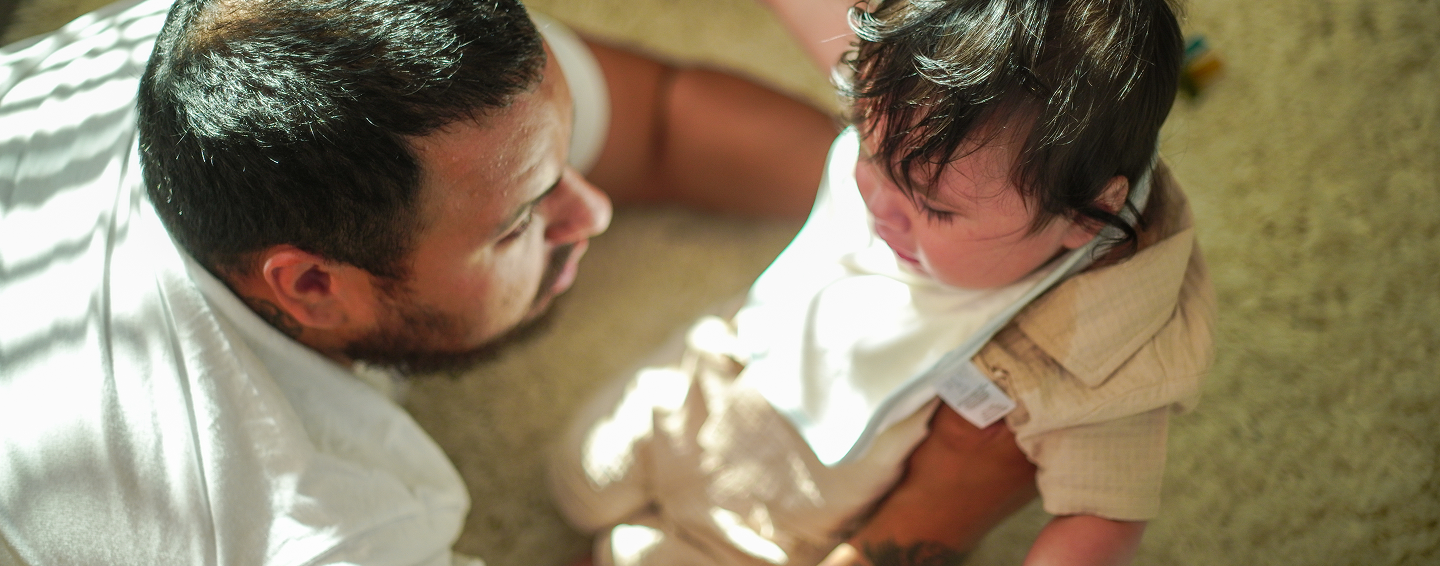Why Finding the Right Nap Duration Changes Everything
Appropriate nap time isn't just about closing your eyes for a few minutes. It's the difference between waking up refreshed or feeling groggier than before you started.
Quick Answer for Optimal Nap Duration:
- Power Nap: 10-20 minutes for instant alertness boost
- Recovery Nap: 90 minutes for full sleep cycle completion
- Best Timing: Between 1-3 PM, before your natural energy dip
- Avoid: Naps longer than 30 minutes (causes sleep inertia) or after 3 PM (disrupts night sleep)
The science is clear. A 20-minute nap can improve your performance by 34% and alertness by 100%, according to NASA research with pilots and astronauts. But get the timing wrong, and you'll wake up feeling worse than when you started.
One in three American adults don't get enough regular sleep. This makes understanding appropriate nap time even more critical for new parents juggling sleepless nights and demanding days.
Sleep happens in stages. Light sleep kicks in during the first 20 minutes. Deep sleep starts around the 60-minute mark. Wake up during deep sleep, and you'll experience sleep inertia - that groggy, disoriented feeling that can last 30 minutes or more.
The timing matters just as much as the duration. Your body has a natural afternoon dip around 1-3 PM, making this the sweet spot for napping. Nap too late, and you'll toss and turn at bedtime.
I'm Gary Harutyunyan, and after struggling with my newborn's sleep challenges as a first-time father, I learned that understanding appropriate nap time became crucial not just for my baby, but for our entire family's well-being. My journey from sleepless nights to creating solutions taught me that the right nap timing can transform your day.

Why Nap? Proven Perks for Body and Brain
Napping isn't just for babies - research consistently shows that strategic napping delivers powerful benefits for both your physical and mental health. When you understand the science behind these benefits, finding the appropriate nap time becomes even more compelling.
Your brain doesn't just "turn off" during naps. Memory consolidation happens as your brain moves important information from short-term to long-term storage. Even a brief 20-minute nap can help you remember where you put those car keys.
The mood boost from well-timed naps is remarkable. Studies show that napping reduces stress markers like interleukin-6, which spike when you're running on empty. Your body literally reduces inflammation and stress hormones during these rest periods.
Cardiovascular health gets a surprising benefit from regular napping. Research indicates that napping once or twice a week is associated with lower risk of heart attack and stroke. The sweet spot is moderation - excessive napping (more than 60 minutes daily) can actually increase health risks.
Your immune system also gets stronger with strategic rest. When you're sleep-restricted, even a short nap helps reverse the negative effects on immune function. This is especially crucial for new parents running on minimal sleep.
Scientific research on napping benefits confirms what many cultures have known for centuries - strategic rest during the day improves overall well-being.
Fast-Acting Benefits in 20 Minutes
The power nap truly lives up to its name. In just 10-20 minutes, you can achieve remarkable improvements in alertness and performance without grogginess.
During this brief window, you primarily stay in Stage 2 sleep - the lighter phases that allow for easy awakening. Your brain waves slow down, your heart rate decreases, and your body temperature drops slightly.
The famous NASA study that revolutionized our understanding of power naps tested military pilots and astronauts. Those who took brief naps showed a 34% improvement in overall performance and a stunning 100% increase in alertness.
What makes the 20-minute window so effective? You avoid entering slow-wave sleep (deep sleep), which typically begins around the 30-60 minute mark. This means you wake up during lighter sleep phases, feeling refreshed rather than groggy.
Full-Cycle Rejuvenation in 90 Minutes
Sometimes you need more than a quick power nap. The 90-minute nap allows you to complete a full sleep cycle, including REM (Rapid Eye Movement) sleep, which brings unique benefits that shorter naps simply can't provide.
During a complete sleep cycle, you progress through all sleep stages: light sleep, deep sleep, and REM sleep. REM consolidation during longer naps improves learning in ways that shorter naps cannot match.
Creativity gets a particular boost from REM sleep. Many breakthrough ideas and solutions to complex problems emerge after REM-rich sleep periods. For parents juggling multiple challenges, this creative problem-solving improvement can be invaluable.
The key to successful 90-minute naps is timing them correctly with your natural sleep cycles. You want to wake up at the end of a complete cycle, not in the middle of deep sleep.
The Science of Ideal Nap Length & Timing
The secret to mastering appropriate nap time lies in understanding how your brain cycles through different sleep stages. It's like knowing when to board a train - timing matters more than you might think.
Your sleep journey starts with Stage 1, a brief transition where you're barely asleep. Stage 2 sleep kicks in around 10-25 minutes and represents true light sleep. This is the sweet spot for power naps. Most of those amazing power nap benefits happen right here in Stage 2.
Stage 3, or slow-wave sleep, begins around 20-40 minutes into your nap. This deep, restorative sleep works wonders for physical recovery, but it's terrible for napping. Wake up during Stage 3, and you'll feel like you've been hit by a truck - that's sleep inertia in action.
Your body actually wants to nap between 1-3 PM. This isn't laziness - it's biology. Your circadian rhythm creates a natural dip during these hours. Your body temperature drops, alertness decreases, and melatonin levels can surge.
Scientific research on nap duration for shift workers shows just how crucial proper timing becomes when your sleep schedule gets disrupted. The principles remain the same whether you're a new parent surviving on three hours of sleep or working irregular shifts.
Avoiding Sleep Inertia: Alarm & Caffeine Hacks
Sleep inertia feels awful - that groggy, confused state where you wonder if napping was a mistake. The good news? You can almost completely avoid it with the right strategies.
The caffeine nap might sound contradictory, but it's actually brilliant. Drink a cup of coffee right before your 20-minute nap. Caffeine takes about 15-20 minutes to hit your bloodstream, so it kicks in just as you're waking up.
Your alarm strategy needs some finesse. Instead of one harsh alarm, try setting two alarms 10 minutes apart. This gives you flexibility to wake up during lighter sleep if your cycles don't align perfectly.
| Nap Duration | Benefits | Sleep Stages | Sleep Inertia Risk | Best For |
|---|---|---|---|---|
| 10-20 minutes | Instant alertness, improved mood | Stage 1-2 (light sleep) | Minimal | Quick energy boost |
| 30 minutes | Improved creativity | Stage 2 + brief Stage 3 | Moderate | Creative problem-solving |
| 60 minutes | Cognitive processing | Includes slow-wave sleep | High | Memory consolidation |
| 90 minutes | Full restoration | Complete cycle including REM | Low (if timed correctly) | Complete recovery |
What you do immediately after waking up matters too. Plan something mildly stimulating - take a short walk, do some gentle stretches, or step outside for natural light.
Best Clock Time to Snooze
That early-afternoon dip between 1-3 PM isn't a coincidence. Your core body temperature naturally drops during this time, and your alertness takes a dive. This biological programming makes falling asleep easier and waking up more natural.
The before 3 PM rule protects your nighttime sleep like a guardian angel. Later naps mess with your sleep drive - that building pressure throughout the day that helps you fall asleep at bedtime.
Your natural chronotype plays a role too. Morning larks might prefer slightly earlier naps around 12:30-2:30 PM, while night owls often do better closer to 2-3 PM.
For parents juggling irregular schedules or shift workers, the key becomes maintaining at least 6-8 hours between your nap and intended bedtime, regardless of what the clock says.
Appropriate Nap Time Across Life Stages
Sleep needs change dramatically as we grow and age. What works for a newborn won't work for a toddler, and adult napping follows completely different rules than baby sleep. Understanding these appropriate nap time patterns helps create better rest for your entire family.
Newborns sleep up to 17 hours daily, cycling between brief wake periods and long stretches of sleep. As children grow, their sleep becomes more organized and predictable. Adults have the flexibility to choose when and how long to nap, but we also risk disrupting our nighttime sleep if we get the timing wrong.
Finding the Appropriate Nap Time for Babies (0–12 months)
Baby sleep operates on a completely different system than adult rest. Instead of fighting fatigue until a set bedtime, babies need to sleep when their developing nervous systems signal they're ready. This is where understanding wake windows becomes absolutely crucial.
Those first three months are intense. Newborns can only handle being awake for 45 to 90 minutes before they become overtired and paradoxically harder to settle. Miss that sweet spot, and you'll find yourself with a cranky baby who fights the very sleep they desperately need.
We call it the SweetSpot – that magical moment when your baby is tired enough to sleep but not so exhausted that they're wired and fussy. Watch for subtle cues like gentle eye rubbing, quieter vocalizations, or simply becoming less interested in toys and faces around them.
By 3 to 6 months, things start getting more predictable. Wake windows stretch to about 1.5 to 2.5 hours, and most babies settle into 3 or 4 naps daily. The second half of the first year brings exciting changes. Wake windows extend to 2 to 4 hours, and most babies consolidate down to 2 or 3 naps each day.
Our comprehensive guide on newborn routines walks you through practical, step-by-step strategies that actually work in real life.
The Appropriate Nap Time for 6-Month-Olds
Six months old represents a sweet spot in baby sleep development. Your little one is finally old enough to have predictable patterns, but still young enough to need substantial daytime sleep – usually 3 to 4 hours spread across 2 or 3 naps.
The classic 9 AM and 1 PM schedule works beautifully for many babies this age. These times align perfectly with natural dips in alertness and provide just the right amount of awake time between sleep periods. That morning nap typically runs 45 minutes to 1.5 hours, while the afternoon stretch can extend to a glorious 2 hours.
Some 6-month-olds still need a brief third nap around 4 or 5 PM, but keep this one short – about 30 to 45 minutes max. Any longer and you'll find bedtime becomes a battle.
Each nap should last at least 45 minutes to complete a full sleep cycle. Those frustrating 30-minute "disaster naps" leave everyone cranky because your baby hasn't achieved truly restorative sleep.
For detailed strategies on mastering this crucial developmental stage, our guide on 6-month-old nap schedules provides practical solutions for common challenges.
Appropriate Nap Time for Adults & Shift Workers
Adult napping requires a completely different mindset than baby sleep. Instead of meeting developmental needs, you're strategically managing alertness and performance while protecting your precious nighttime rest.
That post-lunch dip between 1 and 3 PM isn't just in your imagination – it's a real biological phenomenon. Your body temperature naturally drops slightly, and alertness decreases during this window.
Prophylactic naps – napping before you expect to lose sleep – can be game-changers for shift workers, new parents, or anyone facing an extended period of wakefulness. Taking a solid 90-minute nap before working a night shift significantly improves both performance and safety.
Driver safety represents one of the most critical applications of strategic napping. Drowsy driving causes thousands of preventable accidents every year. A brief 15 to 20-minute roadside nap can be more effective than caffeine alone for restoring alertness.
Creating the Perfect Nap Environment & Routine
Setting up the right environment for your nap can transform a mediocre rest into genuine restoration. Whether you're grabbing a quick power nap or settling in for a longer recovery session, your surroundings play a huge role in how refreshed you'll feel afterward.
Darkness signals your brain that it's time to sleep, even when the sun is shining outside. Blackout curtains work wonders, but even a simple eye mask can make the difference between tossing and turning versus drifting off peacefully.
The magic temperature for appropriate nap time hovers around 65°F (18°C). This might feel slightly cool when you first lie down, but your body temperature naturally drops as you fall asleep.
White noise becomes your secret weapon against the daytime world that keeps humming around you. Consistent, gentle sound creates a protective bubble around your rest.
Safety takes on special importance when you're a parent trying to catch some rest. Never nap with an infant on a couch, chair, or adult bed - the risk of suffocation is real and serious. If you need to rest while caring for your baby, make sure they're secure in their crib or bassinet first.

Quick Pre-Nap Wind-Down
You don't need an elaborate bedtime routine for a daytime nap, but spending just 5 minutes preparing your mind and body can make falling asleep much easier.
Breathing exercises work surprisingly well for this transition. The 4-7-8 technique is simple but effective: breathe in for 4 counts, hold for 7, then exhale slowly for 8. Do this 3-4 times and you'll feel your nervous system start to calm down.
Put the screens away at least 30 minutes before your nap if possible. The blue light from phones and tablets tricks your brain into thinking it's still time to be alert.
If your mind tends to race when you lie down, try progressive muscle relaxation. Start with your toes - tense them for 5 seconds, then let them completely relax. Work your way up through your body.
Set clear intentions for your nap before you close your eyes. Are you going for a quick energy boost with a 20-minute power nap? Or do you have time for a full 90-minute cycle?
Post-Nap Reset
How you wake up from your nap matters just as much as how you fall asleep. The right post-nap routine can eliminate grogginess and leave you feeling genuinely refreshed.
Light exposure should be your first priority when you open your eyes. Step outside for a few minutes if possible, or at least turn on bright lights around you.
Gentle movement gets your blood flowing and shakes off that slightly stiff feeling. You don't need an intense workout - just some simple stretches or walking around for 2-3 minutes does the trick.
Drink a glass of water as soon as you're up and moving. Your body continues losing water through breathing and normal metabolism while you sleep, and mild dehydration can contribute to that foggy post-nap feeling.
Give yourself 5-10 minutes to fully wake up before diving into demanding tasks. This buffer period ensures you're operating at full capacity rather than fighting through sleep inertia.
Frequently Asked Questions about Appropriate Nap Time
How can I tell if my naps are too long?
Your body gives you pretty clear signals when naps exceed their helpful window. The biggest red flag? Waking up feeling worse than when you lay down. That groggy, disoriented feeling - what sleep scientists call sleep inertia - means you've likely awakened during deep sleep instead of the lighter stages.
Nighttime sleep troubles often point to overly long daytime naps. If you're suddenly tossing and turning at bedtime or lying awake for 30+ minutes after your usual routine, your nap may have stolen some of your natural sleepiness.
Physical symptoms tell their own story. Headaches after napping, increased crankiness, or that "foggy brain" feeling that lasts more than 20 minutes all suggest you've ventured into sleep territory that's too deep for a refreshing nap.
For most adults, the magic numbers remain 10-20 minutes for quick energy or 90 minutes for full restoration. That middle ground - the dreaded 30-60 minute range - tends to leave you feeling like you've been hit by a truck.
Will a daily nap ruin my nighttime sleep?
This worry keeps many people from enjoying the benefits of strategic napping, but the answer isn't a simple yes or no. The timing and length of your nap matter far more than the frequency.
Short power naps during that golden 1-3 PM window rarely interfere with nighttime sleep. These brief rest periods work more like hitting a reset button than actually reducing your need for nighttime sleep.
Longer naps are where things get tricky. Once you pass the 30-minute mark, you're providing your body with more substantial rest that can indeed chip away at your nighttime sleepiness.
Late afternoon naps pose the biggest risk to nighttime sleep, regardless of duration. Your circadian rhythm is designed to build alertness in the early evening, and napping during this time works against your natural biology.
Your individual sleep situation matters enormously. If you're a new parent surviving on 4-5 hours of broken sleep, a daily nap might actually improve your nighttime rest by reducing the stress and exhaustion that can make it harder to fall asleep.
The best approach? Pay attention to your own patterns. If you nap daily and still sleep well at night, you've found your rhythm.
When should I talk to a doctor about daytime sleepiness?
Most of us experience occasional afternoon drowsiness, especially after a poor night's sleep. But persistent daytime sleepiness despite adequate nighttime sleep deserves medical attention.
If you're consistently getting 7-9 hours of sleep but still can't stay alert during the day, something else might be going on. Sleep disorders like sleep apnea can leave you exhausted no matter how long you spend in bed.
Sudden changes in your sleep patterns warrant particular attention. Certain warning signs require prompt medical evaluation: falling asleep involuntarily during conversations or while driving, loud snoring followed by periods of silence, or excessive sleepiness paired with morning headaches.
Trust your instincts. You know your body better than anyone. If something feels off with your sleep patterns or energy levels, it's worth having a conversation with your healthcare provider.

Conclusion
Finding the appropriate nap time isn't just about squeezing in some extra rest - it's about strategically using sleep to transform your energy, mood, and overall well-being. Whether you're a sleep-deprived parent or someone looking to optimize daily performance, the science shows that timing truly makes all the difference.
The magic happens when you align your nap duration with your body's natural sleep cycles. Those 10-20 minute power naps deliver instant alertness without the grogginess, while 90-minute naps provide complete restoration including the creative benefits of REM sleep. Miss that sweet spot, and you'll wake up feeling worse than when you started.
Your circadian rhythm creates a perfect napping window between 1-3 PM for most people. This isn't coincidence - it's biology. Your body temperature naturally dips, alertness decreases, and your brain becomes primed for restorative rest.
For families navigating the challenging world of infant sleep, understanding appropriate nap time becomes even more crucial. Those tiny wake windows for newborns, the predictable patterns that emerge around 6 months, and the gradual consolidation of naps all follow biological rhythms that, when respected, make life easier for everyone.
The environment you create matters just as much as the timing. A dark, cool room at 65°F with gentle white noise sets the stage for quality rest. These aren't luxury touches - they're the basic building blocks of restorative sleep.
Don't expect perfection on your first try. Like any skill, strategic napping improves with practice. Pay attention to how different timings affect your energy levels and nighttime sleep quality.
At Sleepy Baby, we've seen how proper sleep support transforms families. Our portable sleep aids provide hands-free soothing with rhythmic patting and white noise, helping babies develop those crucial independent sleep skills while giving exhausted parents the break they desperately need.
The journey to better sleep - whether it's optimizing your own naps or helping your little one develop healthy patterns - starts with understanding these fundamental principles. Appropriate nap time isn't about following rigid rules; it's about working with your body's natural wisdom to create more energy, better moods, and deeper nighttime rest.
For more information about creating healthy sleep habits that support your entire family's well-being, explore our comprehensive sleep solutions designed to make better rest a reality for both babies and parents.





